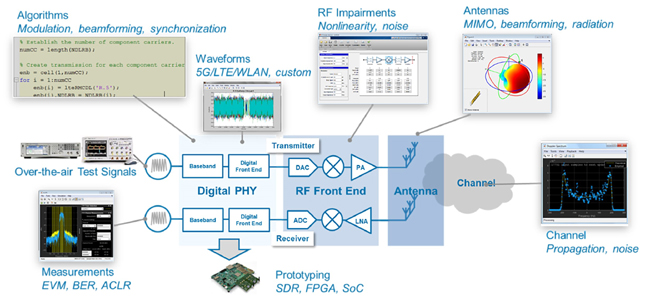Why have today’s wireless communications standards grown so complex?
In the case of 5G, the standard is designed with a highly flexible numerology so devices can operate at different frequencies, data rates, latencies, etc. The 5G NR variable numerology specification uses variable frame sizes instead of the fixed frame size used in LTE. This requires configuration and verification of many more parameters and 10x the number of test cases.
Another reason for complexity is the tighter integration of the digital and RF components in the radio front end of 5G and Wi-Fi 6 devices. For example, engineers need to explore and design new architectures for digitally controlled RF front ends and beamforming with MIMO antenna arrays used in these standards.
What are the specific challenges you’re seeing companies face in terms of designing next-gen communications systems?
The complexity of the 5G standard presents a steep learning curve for companies who need to ensure they have enough engineers who understand the standard and its design and testing requirements. The engineers need to be trained and equipped with tools to validate standard compliance.
Because of the need to explore new architectures for the radio front end, engineers need simulation tools that allow them to design digital, RF and antenna components together and assess component design on the end-to-end link performance.
How prevalent have simulation tools been for designers working in the wireless communications space up to this point?
Simulation tools are commonplace for system design and analysis. However, the most common tools are developed internally by researchers who are not professional software developers and do not provide adequate documentation. This makes it difficult for downstream product designers and verification engineers to use those tools.
Design engineers use low-level simulation tools (e.g., circuit simulators), but the integration of their component or IP designs into the larger system is typically done in the lab with prototype hardware. The majority do not take full advantage of simulation tools that enable them to do the integration virtually, where they can evaluate more test cases and identify errors earlier.
What tools currently exist for designers to assist with their respective wireless communication development challenges that they may have been previously unaware of?
These tools include software for standard-compliant reference designs and waveforms for 5G: 802.11ax (Wi-Fi 6), NB-IoT and C-V2X; simulation tools that enable co-design of baseband algorithms, RF, and antenna components, and tools for prototyping and over-the-air testing algorithms on FPGA- and SoC-based software-defined radios. Many engineers aren’t aware that all of these capabilities exist in a single tool environment such as MATLAB and Simulink.
How can designers streamline their simulation, testing and verification to reduce time to market?
One of the most effective ways is to use a single toolchain for algorithm development, prototyping, and testing. Many designers now develop reference models, testbenches, and waveforms using off-the-shelf commercial software to validate algorithms in simulation. This is particularly helpful when designing for new complex standards like 5G. They then save additional time by reusing those models and waveforms to test hardware prototypes and implementations.
Are there methods available to designers from different disciplines to share information and leverage/coordinate each other’s work?
Multi-domain models are an effective tool to accomplish this. Baseband, RF, and antenna designers can design and validate their component designs and contribute models of those components to end-to-end models. This simplifies the integration of designs from different disciplines and allows accurate measurement of system performance before going to the lab to test hardware prototypes.

A unified design environment enables wireless engineering teams to simulate how the design of baseband, RF, and antenna components affects end-to-end transceiver performance. © 1984–2019 The MathWorks, Inc.
Describe how MathWorks tools help designers build out their simulation, testing, verification, and validation capabilities to overcome their challenges?
MathWorks offers a range of toolboxes and workflow add-ons to enable algorithm development and multi-domain modeling, and to automate implementation and testing of wireless designs. For a complete description of this offering, see MATLAB for Wireless Communications.
How has MathWorks teamed with other companies to offer additional component level simulation tools?
MathWorks works with EDA as well as test & measurement companies to create integrated workflows that connect MATLAB and Simulink to hardware and software for prototyping and verifying wireless and RF designs. One example is an integration between Cadence® Virtuoso® Analog Design Environment (ADE) Product Suite and MATLAB® that enables customers to accelerate processing of large data sets when verifying custom, RF and mixed-signal designs.
How can designers leverage MATLAB algorithms in their systems models?
Many designers build sophisticated system models in MATLAB. In addition, they can adopt coding styles that enable them to automate creation of Simulink blocks from their MATLAB code. In Simulink, they can then use those algorithms in multi-domain models to simulate digital hardware, software, RF, and analog components at a high level of abstraction. Simulink also helps system architects and hardware designers communicate and refine designs to simulate and generate efficient hardware implementations.
What plans does MathWorks have to extend their wireless communications simulation capabilities?
MathWorks continues to invest in its platforms and toolboxes for modeling wireless standards, unifying design and simulation of digital and RF systems, and streamlining workflows for prototyping, testing, and implementing wireless designs.

